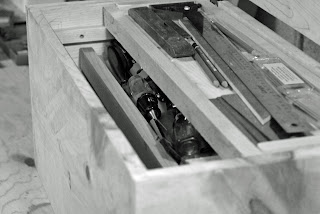First off if you get the opening title joke you are a nerd...and congratulations on that.
So as I hinted to on Wednesday I have begun a new project here in my shop. I am restoring an old, very old in fact, dresser. My family has owned the dresser for around 45 years, but the piece is much older then that. I could not find any dates written on the piece which would give me an exact date of the piece. The construction type and finish on it leads me to believe that it is close to a hundred years old. Also the piece just feels old, the old growth pine feels like it has existed forever and when you touch the piece it feels like it has lived a long life and could tell some stories.
One thing I have to say about having the dresser down in my shop is that "damn does it look good in there". Not the dresser itself but the image of a completed piece of furniture was really cool thing to see in my shop considering this is the first time a whole piece has been on the shop floor. I had to take a few minutes to stand back and just stare at the dresser.
It was one of those moments where I was really excited about what I do and I cannot wait to see a piece of furniture I actually build sitting there just looking good.
So as you can see the dresser is very green. A woodworking crime if you ask me, you will see later what I mean by this. The whole thing is green even the solid brass hardware got a nice coat of green paint. So my job is to remove the paint and apply a new finish to make the piece look good as new.
A nice look at some of the details in the piece. Round over and beads are the predominate details in the piece as well as some carved details.
To remove the paint I started by using a chemical solvent and applied it directly to the paint. After it sitting the for 10 minutes I come back with a paint scraper and pull off the softened paint. After that I go in with the paint scraper and a card scraper and remove all the remaining crud left. Finally I hit the piece with 60 grit to try and expose as much fresh wood as possible, this was to help achieve a uniform finish on the piece when I went to apply stain later on.
To prepare the surface for finish I began with 120 grits sand paper and worked every surface of the piece. Then 180 everywhere, and finally 220 on all exterior surfaces, I am not finishing the inside of the dresser so no need to go that high as well rarely will anyone see the inside.
And with the sanding all finished the piece is ready for finish. I plan on applying a stain and a couple coats of a semi-gloss polyurethane. Now if you excuse me I have a melon juice to drink (nerd joke again).
Cheers
Hans Christopher






















































